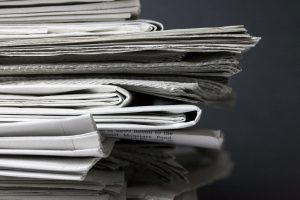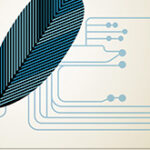By Suzana Liskauskas and Sonia Vasconcelos

Image: Jeff Eaton.
International attention to ethical issues involved in scholarly communication is increasingly evident and has been rising in recent decades. This attention includes that of the public, who has greater access to news about science and the modus operandi of its publication system. In this broad panorama of news, there are cases of misconduct in research and other ethical infractions within the scope of scientific production. Although there is a discrepancy in the percentage of research records that involve misconduct – fabrication, falsification and plagiarism, in the more formal definition of the term – this number would not exceed 2%. However, besides the quantitative factor, the potential scientific and social impact of these cases is a major concern of researchers, educators, and managers.
In the media, the repercussion is usually greater for cases of research misconduct with great potential for application in areas of immediate public interest. In the biomedical sciences, for example, one of the cases with wide international publicity involved the Japanese scientist Yoshiko Sasai, who was considered one of the most respected scientists in developmental biology. Sasai was one of the founders of the Center for Developmental Biology (CDB) at the prestigious RIKEN institute in Japan. Along with collaborators, including the young scientist Haruko Obokata, Sasai had been working on a supposedly promising method of converting somatic cells into pluripotent cells, defined as Stimuli-Triggered Acquisition of Pluripotency (STAP). The results of the study1 were published in the journal Nature in 2014. Obokata was the first author of both articles, whose results would apply in several areas, including regenerative medicine.
For a more objective representation of the expectations surrounding this contribution, we cite a story2 published in 2016 in the American magazine The New Yorker. In the article2, Dana Goodyear reports that “by 2020, according to the consulting firm Frost & Sullivan, stem-cell therapies will be a forty-billion-dollar global industry. STAP seemed to be a bridge to long-held goals of patient-specific drug development, advanced disease modelling, and, ultimately, the ability to regenerate body parts without the risk of immune-system rejection”. The author adds that “Sasai compared STAP to Copernicus’s reorganization of the cosmos. A financial windfall, if not a Nobel Prize, might await its discoverers.” The papers published in Nature in 2014 had immediate repercussions in the media and the scientific community.
Researchers in the area reported difficulty in reproducing the results described in the articles and, subsequently, an investigation indicated that there were serious distortions in the research data. The articles published in January 2014 were retracted in July of the same year. Under the title “STAP retracted”3, the Editorial discusses the retractions and reports that “Underlying these issues, often, is sloppiness, whether in the handling of data, in their analysis, or in the inadequate keeping of laboratory notes… A manifestation of these problems has been a growth in the number of corrections reported in journals in recent years”.
The various repercussions associated with these retractions in academia include the dismantling of the CBD itself and re-readings of the research environment in Japanese institutions that appear to have deepened with Sasai’s suicide in August 2014.
Obituaries published in high-profile scientific journals clearly presented Sasai’s promising scientific trajectory. One of them4, authored by Professor Arturo Alvarez-Buylla, from the University of California at San Francisco, states: “Given the pride that Yoshiki felt for the work he was doing in his home country, his enjoyment of and devotion to good science, his family, and life in general, I was shocked to learn that on 5 August my admired colleague and dear friend had taken his own life. Clearly, his mental state took a very heavy blow from the onslaught of media attention and the months of allegations surrounding two Nature papers published in January from the laboratory of Haruko Obokata”. Sasai would have reported, shortly before the suicide, that he was tired of “unjust bashing in the mass media and the responsibility he felt towards RIKEN and his laboratory”5.
This small exposition of this scenario does not provide sufficient elements for a consideration of the real dimension of this case’s impact on the scientific community itself, on the media and on the public perception of the reasons that may motivate other cases. However, this restricted picture suggests the importance of the role of scientific journalism in cases like this – which open space to promote a broader public understanding of the ethical and social challenges facing today’s research system. Among the factors associated with these challenges is the public trust in science – a source of great concern for researchers and managers.
In the publications’ context, increasing efforts that, to some extent, respond to such challenges are being employed. These efforts aim to intensify the mechanisms of science’s self-regulation and “correction” of research records in scholarly communication. This correction is not always motivated by cases research misconduct, and may occur by identifying an honest error that could invalidate published results. These editorial initiatives multiply the strategies and perceptions about the need to increase the reliability of research recording.
We share the idea that increasing this reliability – of peers and the public’s – is one of the demands that the scientific community has been trying to respond to in a proactive and objective way. Consistent with this idea, the mechanisms of scientific literature correction are being expanded.
Unlike what happened about two decades ago, when the formal correction of a scientific article was rare, today, this resource has been integrating itself into the publishing culture. In this context, the influence of the correction process on the flow and pattern of news about science deserves special attention. In recent years, with increased, and perhaps, more attentive to the news audience, the role of scientific journalism in society also faces additional challenges. In the article “How Journalists Can Help Hold Scientists Accountable”6, published in 2016 in the magazine Pacific Standard, journalist Michael Schulson discusses some of these roles, and makes some provocations. In one of them, Schulson describes that “Journalists typically don’t say that ‘facts change’; it is a journalist’s job to define and publicize facts…”. The author adds that “At even the most respected publications, science journalists tend to position themselves as translators, churning the technical language of scientific papers into summaries that are accessible to the public”. In Schulson’s view, “The assumption is that the source text they’re translating—the original scientific research—comes to them as unimpeachable fact”.
Schulson’s perspective may be considered exaggerated by some scientific journalists, but seems to meet questions already posed by Boyce Rensberger on an essay7 published in Nature. Rensberger directed the Knight Science Journalism Fellowship Program at the Massachusetts Institute of Technology (MIT), from 1998 to 2008. To the author, “if science journalists are to regain relevance to society, not only must they master the new media, they must learn enough science to analyze and interpret the findings — including the motives of the funders”.
Recently, Kathleen Hall Jamielson, director of the Annenberg Public Policy Center at the University of Pennsylvania, discusses the analysis of narratives she considers misguided in the media in an article8 published in PNAS, pointing to the need for a change in the way the process of self-correction of science has been communicated to the public. One of the ideas the author encourages is that there has been an imbalance between the disclosure of violations of scientific integrity and the attempts to avoid them. The author highlights the role of journalist in “increas[ing] the accuracy of public understanding and minimiz[ing] public vulnerability to distortions of science”9. In the context of correcting the literature, Hall Jamielson reinforces Fanelli’s perspective and Marcus and Oransky’s. According to these perspectives increased retraction, for example, would be a good sign (in terms of responding to the problem), indicating that the self-regulation of science would be working.
Although there are other factors that deepen our understanding on retractions, an issue that emerges in this panorama is how the process of correcting the literature must be articulated with the dynamics of disseminating news about science. For the public-science interface, the exposure to this growing correctional activity opens a unique space that can strengthen public understanding about science, its self-regulation mechanisms and accountability. How to explore this space, strongly articulated with assumptions of scientific integrity, is one of the challenges facing all of those who are working in this interface – including scientific journalists. As previously noted, “society needs to see science scrutinized as well as regurgitated if it is to give science its trust, and journalists are an important part of that process”10.
Notes
1. CYRANOSKI, D. Papers on ‘stress-induced’ stem cells are retracted [online]. Nature. 2014 [viewed 24 July 2018]. Available from: https://doi.org/10.1038/nature.2014.15501
2. GOODYEAR, D. The Stress Test [online]. The New Yorker. 2016 [viewed 24 July 2018]. Available from: https://www.newyorker.com/magazine/2016/02/29/the-stem-cell-scandal
3. STAP Retracted. Nature [online]. 2014, vol. 511, no. 7507, pp. 5-6, ISSN: 1476-4687 [viewed 24 July 2018]. DOI: 10.1038/511005b. Available from: https://www.nature.com/news/stap-retracted-1.15488
4. ALVAREZ-BUYLLA, A. Yoshiki Sasai (1962-2014). Nature [online]. 2014, vol. 513, no. 7516, pp. 34, ISSN: 1476-4687 [viewed 24 July 2018]. DOI: 10.1038/513034a. Available from: https://www.nature.com/articles/513034a
5. CYRANOSKI, D. Stem-cell pioneer blamed media ‘bashing’ in suicide note [online]. Nature. 2014 [viewed 24 July 2018]. Available from: https://doi.org/10.1038/nature.2014.15715
6. SCHULSON, M. How Journalists Can Help Hold Scientists Accountable [online]. Pacific Standard. 2016 [viewed 24 July 2018]. Available from: https://psmag.com/environment/journalists-should-hold-scientists-accountable/
7. RENSBERGER, B. Science journalism: Too close for comfort. Nature [online]. 2009, vol. 459, no. 7250, pp. 1055-1056, ISSN: 1476-4687 [viewed 24 July 2018]. DOI: 10.1038/4591055a. Available from: https://www.nature.com/articles/4591055a
8. JAMIESON, K.H. Crisis or self-correction: Rethinking media narratives about the well-being of science. PNAS [online]. 2018, vol. 115, no. 11, pp. 2620-2627 [viewed 24 July 2018]. DOI: 10.1073/pnas.1708276114. Available from: http://www.pnas.org/content/115/11/2620
9. HERTZIER, L. Why media should rethink the way it covers science [online]. Penn Today. 2018 [viewed 24 July 2018]. Available from: https://penntoday.upenn.edu/news/why-media-should-rethink-way-it-covers-science
10. Cheerleader or watchdog? Nature [online]. 2009, vol. 459, no. 7250, pp. 1033, ISSN: 1476-4687 [viewed 24 July 2018]. DOI: 10.1038/4591033a. Available from: https://www.nature.com/articles/4591033a
References
ALVAREZ-BUYLLA, A. Yoshiki Sasai (1962-2014). Nature [online]. 2014, vol. 513, no. 7516, pp. 34, ISSN: 1476-4687 [viewed 24 July 2018]. DOI: 10.1038/513034a. Available from: https://www.nature.com/articles/513034a
Cheerleader or watchdog? Nature [online]. 2009, vol. 459, no. 7250, pp. 1033, ISSN: 1476-4687 [viewed 24 July 2018]. DOI: 10.1038/4591033a. Available from: https://www.nature.com/articles/4591033a
CYRANOSKI, D. Papers on ‘stress-induced’ stem cells are retracted [online]. Nature. 2014 [viewed 24 July 2018]. Available from: https://doi.org/10.1038/nature.2014.15501
CYRANOSKI, D. Stem-cell pioneer blamed media ‘bashing’ in suicide note [online]. Nature. 2014 [viewed 24 July 2018]. Available from: https://doi.org/10.1038/nature.2014.15715
CYRANOSKI, D. Stem-cell scientist found guilty of misconduct [online]. Nature. 2014 [viewed 24 July 2018]. Available from: https://doi.org/10.1038/nature.2014.14974
FANELLI, D. How Many Scientists Fabricate and Falsify Research? A Systematic Review and Meta-Analysis of Survey Data. PLoS ONE [online]. 2009, vol. 4, no. 5, e5738 [viewed 24 July 2018]. DOI: 10.1371/journal.pone.0005738. Available from: http://journals.plos.org/plosone/article?id=10.1371/journal.pone.0005738
FANELLI, D. Why growing retractions are (mostly) a good sign. PLoS Medicine [online]. 2013, vol. 10, no. 12, e1001563 [viewed 24 July 2018]. DOI: 10.1371/journal.pmed.1001563. Available from: http://journals.plos.org/plosmedicine/article?id=10.1371/journal.pmed.1001563
FANG, F.C., STEEN, R.G. AND CASADEVALL, A. Misconduct accounts for the majority of retracted scientific publications. PNAS [online]. 2012, vol. 109, no. 42, pp. 17028-17033 [viewed 24 July 2018]. DOI: 10.1073/pnas.1212247109. Available from: http://www.pnas.org/content/109/42/17028
GOODYEAR, D. The Stress Test [online]. The New Yorker. 2016 [viewed 24 July 2018]. Available from: https://www.newyorker.com/magazine/2016/02/29/the-stem-cell-scandal
HERTZIER, L. Why media should rethink the way it covers science [online]. Penn Today. 2018 [viewed 24 July 2018]. Available from: https://penntoday.upenn.edu/news/why-media-should-rethink-way-it-covers-science
JAMIESON, K.H. Crisis or self-correction: Rethinking media narratives about the well-being of science. PNAS [online]. 2018, vol. 115, no. 11, pp. 2620-2627 [viewed 24 July 2018]. DOI: 10.1073/pnas.1708276114. Available from: http://www.pnas.org/content/115/11/2620
LOHWATER, T. Public Confidence in Science Needs Work to Maintain [online]. AAAS. 2018 [viewed 24 July 2018]. Available from: https://www.aaas.org/news/public-confidence-science-needs-work-maintain
MARCUS, A. and ORANSKY, I. Is There a Retraction Problem? And, If So, What Can We Do About It? In: Jamieson, K.H., KAHAN, D.M. and SCHEUFELE, D.A. (ed.) The Oxford Handbook of the Science of Science Communication. New York: Oxford University Press, 2017.
RENSBERGER, B. Nature [online]. 2009, vol. 459, no. 7250, pp. 1055-1056, ISSN: 1476-4687 [viewed 24 July 2018]. DOI: 10.1038/4591055a. Available from: https://www.nature.com/articles/4591055a
SCHULSON, M. How Journalists Can Help Hold Scientists Accountable [online]. Pacific Standard. 2016 [viewed 24 July 2018]. Available from: https://psmag.com/environment/journalists-should-hold-scientists-accountable/
SPINAK, E. Ethical Publishing – the time line of a case of plagiarism [online]. SciELO in Perspective, 2014 [viewed 24 July 2018]. Available from: https://blog.scielo.org/en/2014/05/22/ethical-publishing-the-time-line-of-a-case-of-plagiarism/
SPITZER, K. Science Scandal Triggers Suicide, Soul-Searching in Japan [online]. Time. 2014 [viewed 24 July 2018]. Available from: http://time.com/3091584/japan-yoshiki-sasai-stem-cells-suicide-haruko-obokata/
STAP Retracted. Nature [online]. 2014, vol. 511, no. 7507, pp. 5-6, ISSN: 1476-4687 [viewed 24 July 2018]. DOI: 10.1038/511005b. Available from: https://www.nature.com/news/stap-retracted-1.15488
STERN, et al. Financial costs and personal consequences of research misconduct resulting in retracted publications. eLife [online]. 2014, vol. 3 [viewed 24 July 2018]. DOI: 10.7554/eLife.02956. Available from: https://www.ncbi.nlm.nih.gov/pmc/articles/PMC4132287/
External links
Sonia Vasconcelos <http://buscatextual.cnpq.br/buscatextual/visualizacv.do?id=K4776286J6>
Suzana Liskauskas <http://buscatextual.cnpq.br/buscatextual/visualizacv.do?id=K4247770H3>
About Suzana Liskauskas
Masters student at the Professional Masters for Science Education at the Institute of Medical Biochemistry Leopoldo de Meis (IBqM)/UFRJ. She has studied the influence of retractions on patterns of science news. Specialist in Neurosciences Applied to Learning, by the Institute of Psychiatry/UFRJ. She is a journalist, with 20-year work experience, including that in Globo Ciência, Jornal do Brasil, O Globo and Jornal da Ciência (SBPC).
About Sonia Vasconcelos
Associate Professor at the Science Education Program of the Institute of Medical Biochemistry Leopoldo de Meis (IBqM) / UFRJ; coordinator of the Advisory Graduate Council for Research Ethics/ Pro-Rectory for Research and Graduate Studies/UFRJ. She teaches research methodology, research ethics and science communication at UFRJ. Among her research interests is the dynamics of science communication and its relationship with research ethics and science policy.
Translated from the original in Portuguese by Lilian Nassi-Calò.
Como citar este post [ISO 690/2010]:



















Read the comment in spanish, by Javier Santovenia Diaz:
https://blog.scielo.org/es/2018/07/24/interfaz-ciencia-publico-en-tiempos-de-correccion-de-la-literatura-cientifica-cuestiones-eticas-contemporaneas/#comment-41732